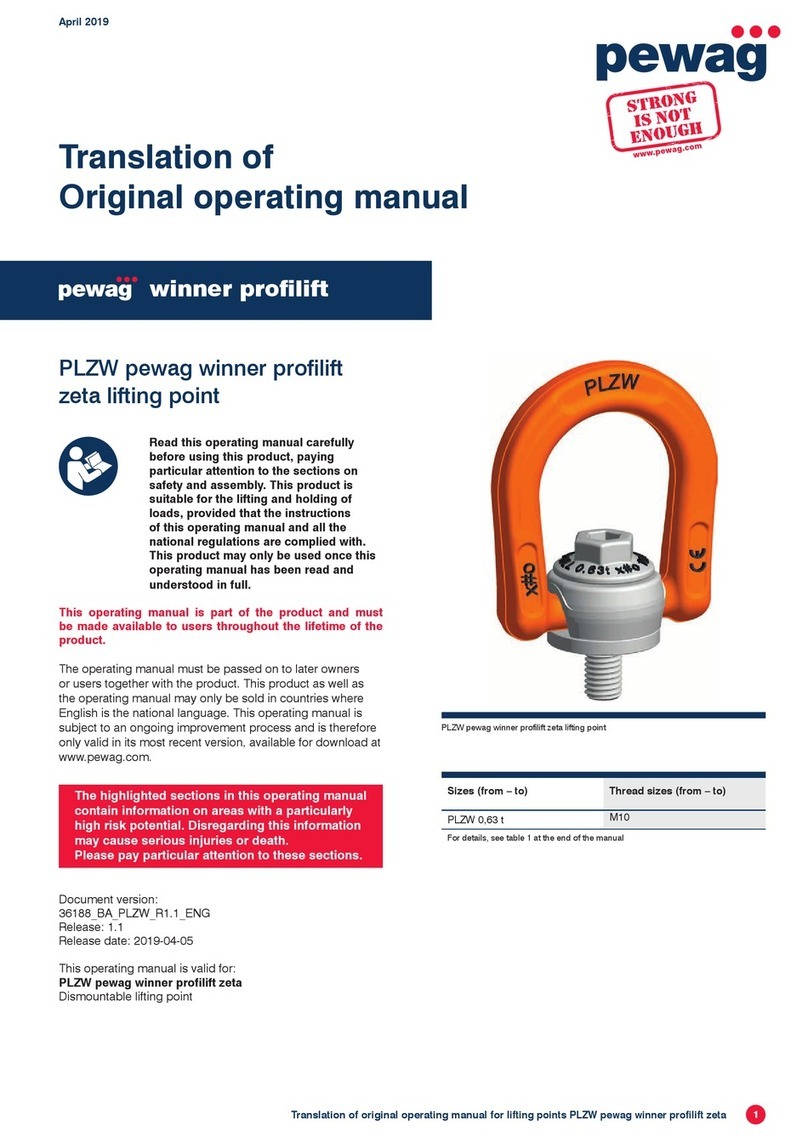
December 2020
4
Translation of original operating manual for
anchorage points PLGWI-PSA pewag winner gamma inox
• PLGWI-PSA anchorage points are to be screwed into steel
or cast steel parts only. Applying to other materials
(as light metals, plastic, concrete, etc.) is not permissible
• Choose the location of the anchorage point so that in the
event of a fall, no impact on the surface or with any other
obstacle can occur.
• Always consider the usage and assembly instructions of
the connecting elements used.
• For custom-made designs: Take into account the additional
information provided and the specifications on the
customer‘s drawings (where applicable).
• The condition as delivered must not be altered.
Surface treatments that may damage the material, welding,
heat treatments etc. are not permitted.
• The length of the thread may not be shortened.
• Do not use an extension during mounting.
3.2 Protective measures to be taken
by the user
Please refer to the operational limitations and the maximum
number of permitted person according to table 1. Make sure
that no unauthorised persons have access to the anchorage
system during the entire duration of operation.
3.3 Remaining risks
Overloading by not respecting the maximum number
of persons or due to undue environmental influences
(temperature etc.). Wrong adjustment of connecting elements
can also lead to the failing of the anchorage points, as well as
using unauthorised or damaged body harness’ parts (ropes,
fall-impact-absorbers, tether).
3.4 Mounting
• The screw-on surface must be level and have at least the
diameter of the contact surface of the anchorage point. The
sufficiently deep, threaded hole must be at the centre of the
contact surface, at a right angle.
It must be possible to insert the screw fully
(with blind holes).
• Clean the threaded hole prior to each use and check for
damage.
• The minimum screw penetration values are:
1 x M for steel (Rm > 360N/mm²)
1.25 x M for cast steel
(M = thread size, e.g. M20 = 20 mm)
• Additional elements (such as washers) between the
anchorage point and the anchorage system are not
permitted.
• Prior to each use, ensure that the anchorage point is fully
screwed in and that the contact surface is flush with the load.
• If the anchorage point is intended to remain permanently
attached to the anchorage system, it must be tightened
with an appropriate tool with a torque as listed in table 1.
If necessary (i.e. in case of vibrations), the thread must be
secured with a liquid threadlock (e.g. Loctite).
• After assembly, ensure that there is no risk of incorrect
loading by aligning the anchorage point in the expected
load direction by moving the ring.
3.5 Dismounting
To remove the anchorage point, unscrew it with a suitable
tool. Store the anchorage point as described in „Storage“.
Take appropriate measures to protect the thread on the
anchorage system from damage and dirt.
A suitable tool for assembly and disassembly can be found
in the current catalog, resp. please contact our technical
service.
4. Inspection, maintenance,
repair
• This product must be inspected by a competent
person at least once a year and in accordance with the
manufacturer‘s instructions. Depending on the conditions
of use and legal stipulations, this interval may be shorter.
In case of frequent use, we recommend a crack test every
two years.
• During tests, all parts must be checked for damage that
could impact safety and function.
• For the regular inspection and the crack test, all parts must
be free from oil, dirt and rust.
Appropriate cleaning processes include those that do not
cause overheating, cover up surface defects or cause
hydrogen embrittlement or stress crack corrosion.
• Load testing all the way up to the proof force is not
permitted for these anchorage points.
Competent persons are persons who are capable of
assessing the operationality and correct usage of this
product, either based on their technical qualifications
(e.g. training) or their experience with and sufficient
knowledge of the use of personal fall protection equipment,
and who are familiar with the relevant standards and
regulations.
If you are interested in an expert training module, please
contact our technical service.
The safety of the user
is contingent upon
the effectiveness
and durability of the
equipment used. For this reason, ensure that
inspections are performed on a regular basis.
Damaged anchorage points may fail during normal
conditions of use.
Make sure that there
is no danger of falling
before removing the
anchorage system.
























